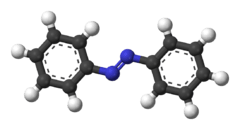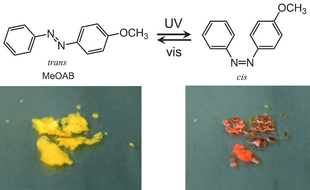Azobenzene
Azobenzene is a chemical compound composed of two phenyl rings linked by a N=N double bond. It is the simplest example of an aryl azo compound. The term 'azobenzene' or simply 'azo' is often used to refer to a wide class of similar compounds. These azo compounds are considered as derivatives of diazene (diimide),[4] and are sometimes referred to as 'diazenes'. The diazenes absorb light strongly and are common dyes.
-1%2C2-diphenyldiazene_200.svg.png) | |
 | |
| Names | |
|---|---|
| IUPAC name
(E)-Diphenyldiazene | |
| Other names
Azobenzene | |
| Identifiers | |
3D model (JSmol) |
|
| 742610 | |
| ChEBI | |
| ChEMBL | |
| ChemSpider | |
| ECHA InfoCard | 100.002.820 |
| EC Number |
|
| 83610 | |
| KEGG | |
PubChem CID |
|
| RTECS number |
|
| UNII | |
CompTox Dashboard (EPA) |
|
| |
| |
| Properties | |
| C12H10N2 | |
| Molar mass | 182.226 g·mol−1 |
| Appearance | orange-red crystals[1] |
| Density | 1.203 g/cm3[1] |
| Melting point | 67.88 °C (trans), 71.6 °C (cis) [1] |
| Boiling point | 300 °C (572 °F; 573 K)[1] |
| 6.4 mg/L (25 °C) | |
| Acidity (pKa) | -2.95[2] |
| -106.8·10−6 cm3/mol[3] | |
Refractive index (nD) |
1.6266 (589 nm, 78 °C)[1] |
| Structure | |
| sp2 at N | |
| 0 D (trans isomer) | |
| Hazards | |
| Main hazards | toxic |
| GHS pictograms |    |
| GHS Signal word | Danger |
GHS hazard statements |
H302, H332, H341, H350, H373, H400, H410 |
| P201, P202, P260, P261, P264, P270, P271, P273, P281, P301+312, P304+312, P304+340, P308+313, P312, P314, P330, P391, P405, P501 | |
| Flash point | 476 °C (889 °F; 749 K) |
| Related compounds | |
Related compounds |
Nitrosobenzene aniline |
Except where otherwise noted, data are given for materials in their standard state (at 25 °C [77 °F], 100 kPa). | |
| Infobox references | |
Structure and synthesis

trans-Azobenzene is planar. The N-N distance is 1.189 Å.[5] cis-Azobenzene is nonplanar with a C-N=N-C dihedral angle of 173.5°. The N-N distance is 1.251 Å.[6] Azobenzene was first described by Eilhard Mitscherlich in 1834.[7][8] Yellowish-red crystalline flakes of azobenzene were obtained in 1856.[9] Its original preparation is similar to the modern one. According to the 1856 method, nitrobenzene is reduced by iron filings in the presence of acetic acid. In the modern synthesis, zinc is the reductant in the presence of a base.[10] Industrial electrosynthesis using nitrobenzene is also employed.[11]
The trans isomer is more stable by approximately 50 kJ/mol, and the barrier to isomerization in the ground state is approximately 100 kJ/mol.


Reactions
Azobenzene is a weak base, but undergoes protonation at one nitrogen with a pKa = -2.95. It functions as a Lewis base, e.g. toward boron trihalides. It binds to low valence metal centers, e.g. Ni(Ph2N2)(PPh3)2 is well characterized.[12]
It oxidizes to give azoxybenzene. Hydrogenation gives diphenylhydrazine
Trans-cis isomerization
Azobenzene (and derivatives) undergo photoisomerization of trans and cis isomers. cis-Azobenzene relaxes back, in dark, to the trans isomer. Such thermal relaxation is slow at room temperature. The two isomers can be switched with particular wavelengths of light: ultraviolet light, which corresponds to the energy gap of the π-π* (S2 state) transition, for trans-to-cis conversion, and blue light, which is equivalent to that of the n-π* (S1 state) transition, for cis-to-trans isomerization. For a variety of reasons, the cis isomer is less stable than the trans (for instance, it has a distorted configuration and is less delocalized than the trans configuration). Photoisomerization allows for reversible energy storage (as photoswitchs).
Spectroscopic classification
The wavelengths at which azobenzene isomerization occurs depends on the particular structure of each azo molecule, but they are typically grouped into three classes: the azobenzene-type molecules, the aminoazobenzenes, and the pseudo-stilbenes. These azos are yellow, orange, and red, respectively,[13][14] owing to the subtle differences in their electronic absorption spectra. The compounds similar to the unsubstituted azobenzene exhibit a low-intensity n-π* absorption in the visible region, and a much higher intensity π-π* absorption in the ultraviolet. Azos that are ortho- or para-substituted with electron-donating groups (such as aminos), are classified as aminoazobenzenes, and tend to closely spaced[13] n-π* and π-π* bands in the visible. The pseudo-stilbene class is characterized by substituting the 4 and 4' positions of the two azo rings with electron-donating and electron-withdrawing groups (that is, the two opposite ends of the aromatic system are functionalized). The addition of this push-pull configuration results in a strongly asymmetric electron distribution, which modifies a host of optical properties. In particular, it shifts the absorption spectra of the trans and the cis isomers, so that they effectively overlap.[14] Thus, for these compounds a single wavelength of light in the visible region will induce both the forward and reverse isomerization. Under illumination, these molecules cycle between the two isomeric states.
Photophysics of isomerization
The photo-isomerization of azobenzene is extremely rapid, occurring on picosecond timescales. The rate of the thermal back-relaxation varies greatly depending on the compound: usually hours for azobenzene-type molecules, minutes for aminoazobenzenes, and seconds for the pseudo-stilbenes.[14]
The mechanism of isomerization has been the subject of some debate, with two pathways identified as viable: a rotation about the N-N bond, with disruption of the double bond, or via an inversion, with a semi-linear and hybridized transition state. It has been suggested that the trans-to-cis conversion occurs via rotation into the S2 state, whereas inversion gives rise to the cis-to-trans conversion. It is still under discussion which excited state plays a direct role in the series of the photoisomerization behavior. However, the latest research on femtosecond transition spectroscopy has suggested that the S2 state undergoes internal conversion to the S1 state, and then the trans-to-cis isomerization proceeds. Recently another isomerization pathway has been proposed by Diau,[15] the "concerted inversion" pathway in which both CNN bond angles bend at the same time.
Photoinduced motions
The photo-isomerization of azobenzene is a form of light-induced molecular motion.[13][16][17] This isomerization can also lead to motion on larger length scales. For instance, polarized light will cause the molecules to isomerize and relax in random positions. However, those relaxed (trans) molecules that fall perpendicular to the incoming light polarization will no longer be able to absorb, and will remain fixed. Thus, there is a statistical enrichment of chromophores perpendicular to polarized light (orientational hole burning). Polarized irradiation will make an azo-material anisotropic and therefore optically birefringent and dichroic. This photo-orientation can also be used to orient other materials (especially in liquid crystal systems).[18]
References
- Haynes, p. 3.32
- Hoefnagel, M. A.; Van Veen, A.; Wepster, B. M. (1969). "Protonation of azo-compounds. Part II: The structure of the conjugate acid of trans-azobenzene". Recl. Trav. Chim. Pays-Bas. 88 (5): 562–572. doi:10.1002/recl.19690880507.
- Haynes, p. 3.579
- IUPAC, Compendium of Chemical Terminology, 2nd ed. (the "Gold Book") (1997). Online corrected version: (2009) "azo compounds". doi:10.1351/goldbook.A00560
- Harada, J.; Ogawa, K.; Tomoda, S. (1997). "Molecular Motion and Conformational Interconversion of Azobenzenes in Crystals as Studied by X-ray Diffraction". Acta Crystallogr. B. 53 (4): 662. doi:10.1107/S0108768197002772.
- Mostad, A. and Rømming, C. (1971). "A Refinement of the Crystal Structure of cis-Azobenzene". Acta Chem. Scand. 25: 3561. doi:10.3891/acta.chem.scand.25-3561.CS1 maint: uses authors parameter (link)
- Mitscherlich, E. (1834). "Ueber das Stickstoffbenzid". Ann. Pharm. 12 (2–3): 311–314. Bibcode:1834AnP...108..225M. doi:10.1002/jlac.18340120282.
- Merino, Estíbaliz and Ribagorda Beilstein, María (2012). "Control over molecular motion using the cis–trans photoisomerization of the azo group". J. Org. Chem. 8: 1071–1090. doi:10.3762/bjoc.8.119. PMC 3458724. PMID 23019434.CS1 maint: multiple names: authors list (link)
- Noble, Alfred (1856). "III. Zur Geschichte des Azobenzols und des Benzidins". Annalen der Chemie und Pharmacie. 98 (2): 253–256. doi:10.1002/jlac.18560980211.
- Bigelow, H. E.; Robinson, D. B. (1955). "Azobenzene". Organic Syntheses. 22: 28.; Collective Volume, 3, p. 103
- Cardoso, D. S.; Šljukić, B.; Santos, D. M.; Sequeira, C. A. (July 17, 2017). "Organic Electrosynthesis: From Laboratorial Practice to Industrial Applications". Organic Process Research & Development. 21 (9): 1213–1226. doi:10.1021/acs.oprd.7b00004.
- Fedotova, Yana V.; Kornev, Alexander N.; Sushev, Vyacheslav V.; Kursky, Yurii A.; Mushtina, Tatiana G.; Makarenko, Natalia P.; Fukin, Georgy K.; Abakumov, Gleb A.; Zakharov, Lev N.; Rheingold, Arnold L. (2004). "Phosphinohydrazines and phosphinohydrazides M(–N(R)–N(R)–PPh2)n of some transition and main group metals: synthesis and characterization: Rearrangement of Ph2P–NR–NR– ligands into aminoiminophosphorane, RNPPh2–NR–, and related chemistry". J. Organomet. Chem. 689 (19): 3060–3074. doi:10.1016/j.jorganchem.2004.06.056.
- Rau, H. (1990). Rabek, J. F. (ed.). Photochemistry and Photophysics. 2. Boca Raton, FL: CRC Press. pp. 119–141. ISBN 978-0-8493-4042-0.
- Yager, K. G.; Barrett, C. J. (2008). "Chapter 17 - Azobenzene Polymers as Photomechanical and Multifunctional Smart Materials". In Shahinpoor, M.; Schneider, H.-J. (eds.). Intelligent Materials. Cambridge: Royal Society of Chemistry. pp. 426–427. doi:10.1039/9781847558008-00424. ISBN 978-1-84755-800-8.
- Diau, E. W.-G. (2004). "A New Trans-to-Cis Photoisomerization Mechanism of Azobenzene on the S1(n,π*) Surface". The Journal of Physical Chemistry A. 108 (6): 950–956. Bibcode:2004JPCA..108..950W. doi:10.1021/jp031149a. S2CID 54662441.
- Natansohn A.; Rochon, P. (November 2002). "Photoinduced motions in azo-containing polymers". Chemical Reviews. 102 (11): 4139–4175. doi:10.1021/cr970155y. PMID 12428986.
- Yu, Y.; Nakano, M.; Ikeda, T. (2003). "Photomechanics: Directed bending of a polymer film by light". Nature. 425 (6954): 145. Bibcode:2003Natur.425..145Y. doi:10.1038/425145a. PMID 12968169.
- Ichimura, K. (2000). "Photoalignment of Liquid-Crystal Systems". Chemical Reviews. 100 (5): 1847–1874. doi:10.1021/cr980079e. PMID 11777423.
Cited sources
- Haynes, William M., ed. (2011). CRC Handbook of Chemistry and Physics (92nd ed.). Boca Raton, FL: CRC Press. p. 3.32. ISBN 1439855110.
Further reading
| Wikimedia Commons has media related to Azobenzene. |
- Of historic interest: G. S. Hartley (1937). "The cis form of Azobenzene". Nature. 140 (3537): 281. Bibcode:1937Natur.140..281H. doi:10.1038/140281a0.
- Torres-Zúñiga, V.; Morales-Saavedra, O. G.; Rivera, E.; Castañeda-Guzmán, R.; Bañuelos, J. G.; Ortega-Martínez, R. (2010). "Preparation and photophysical properties of monomeric liquid-crystalline azo-dyes embedded in bulk and film SiO2-sonogel glasses". Journal of Sol-Gel Science and Technology. 56 (1): 7–18. doi:10.1007/s10971-010-2265-y.
- Tazuke, S.; Kurihara, S.; Ikeda, T. (1987). "Amplified image recording in liquid crystal media by means of photochemically triggered phase transition". Chemistry Letters. 16 (5): 911–914. doi:10.1246/cl.1987.911.
- Tamaoki, N. (2001). "Cholesteric Liquid Crystals for Color Information Technology". Advanced Materials. 13 (15): 1135–1147. doi:10.1002/1521-4095(200108)13:15<1135::AID-ADMA1135>3.0.CO;2-S.
- Pieraccini, S.; Masiero, S.; Spada, G. P.; Gottarelli, G. (2003). "A new axially-chiral photochemical switch". Chemical Communications. 2003 (5): 598–599. doi:10.1039/b211421f. PMID 12669843.
- Yager, K. G.; Barrett, C. J. (2006). "Photomechanical Surface Patterning in Azo-Polymer Materials". Macromolecules. 39 (26): 9320–9326. Bibcode:2006MaMol..39.9320Y. doi:10.1021/ma061733s.
- Gorostiza, P.; Isacoff, E. Y. (October 2008). "Optical switches for remote and noninvasive control of cell signaling". Science. 322 (5900): 395–399. Bibcode:2008Sci...322..395G. doi:10.1126/science.1166022. PMID 18927384.
- Banghart, M. R.; Volgraf, M.; Trauner, D. (December 2006). "Engineering light-gated ion channels". Biochemistry. 45 (51): 15129–15141. CiteSeerX 10.1.1.70.6273. doi:10.1021/bi0618058. PMID 17176035.